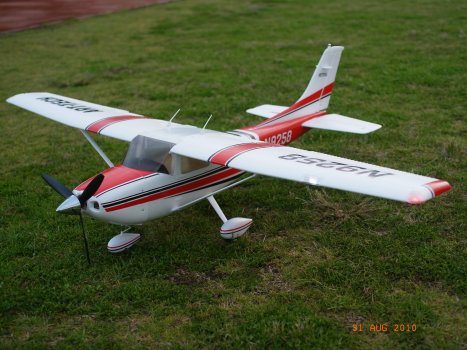 Well, class by name and even classier in the flesh, the Art-Tech 500 Class Cessna 182 is certainly a high end product. We have already reviewed the baby brother Cessna 182, which is now amongst the 16 or so RC electric aeroplanes that will be included in the Comparative Grid which is likely to be completed in early November 2010. Rumours say that this ‘plane is probably the cream of the EGO Importer models and initial findings all point to this being true.
Well, class by name and even classier in the flesh, the Art-Tech 500 Class Cessna 182 is certainly a high end product. We have already reviewed the baby brother Cessna 182, which is now amongst the 16 or so RC electric aeroplanes that will be included in the Comparative Grid which is likely to be completed in early November 2010. Rumours say that this ‘plane is probably the cream of the EGO Importer models and initial findings all point to this being true.
Does it look as good as it’s rumoured? Does it fly as well as it looks? (See 21 Best RC electric planes compared – this site)
Come with us for a Birdseye view as we put it through some stringent tests we’ve marked all the rest on.
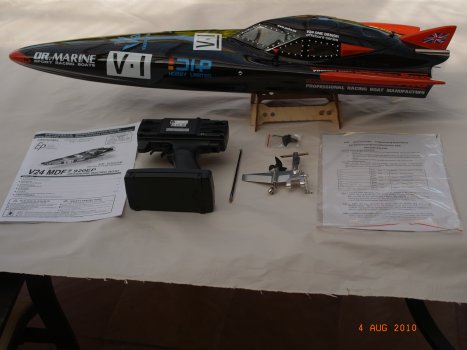 We can already say that we have not ever seen such a well packed remote controlled model aeroplane – everything was wrapped in bubble wrap and carefully positioned in the box.
We can already say that we have not ever seen such a well packed remote controlled model aeroplane – everything was wrapped in bubble wrap and carefully positioned in the box.
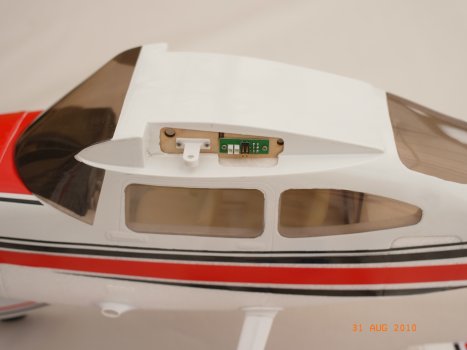 Assembly comments
Assembly comments
Let’s start at the beginning and say that when the manufacturers claim you get all you need to make it fly, you really do. So many times we assemble these ‘planes only to find that you don’t get glue or something similar. In fact, this is one of the most complete packages we have come across. Cast your eyes over the photos and you will see that even Epoxy resin glue, a screwdriver and an allen key is provided. We received three propellers in ours (but the manual did say that two should be provided). You are even supplied with a flight simulator to get some practice on, and yes, it does plug straight into the Transmitter that you will use to fly the plane.
Even the manual oozes class as it has the first front page in colour that we have seen. It generates trust when you see that and QC stickers on various parts of the ‘plane. We weren’t let down as the manual did not have the usual grammatical errors and lack of logical progression that we usually see in them. We did read that this ‘plane can be hand launched which we found to be very surprising for such a large ‘plane.
This ‘plane comes with flaps and we have to state that the build quality and attention to detail is exemplary. There is NO sloppiness in any of the control assemblies which is something we look for both as an indication of quality and it’s potential to become a consistently predictable flier.
Standing behind the plane, the right hand side of the main wing has a small electrical connector for the LED navigation lights but has two sockets on the fuselage and it is not quite clear which socket to put the plug into, we took a guess and it worked fine, but the manufacturers could give better instruction or colour code the matching parts. All other sockets are marked clearly. We did find that it was difficult to start the four screws that go into the main wing supports. We used a 1/32nd drill bit but any pointed instrument or more pressure on the screws should suffice. We understand that it would not be prudent to have these factory pre drilled as the make its own hole method ensures everything is a precise fitment, and we wouldn’t want to upset the manufacturer of this plane’s impeccable record.
The main wing struts are oval and of sturdy but light construction and it is great to see that they have used sound engineering principles (i.e. the oval shape is positioned to give maximum strength in the direction that any impact is likely to come from). When assembling the stabilizer/elevator and rudder control rods, they do not tell you that the elevator is the short rod. They should do so as this can cause some problems if you glue it all in and have used the wrong rod on either of the rudder or elevator.
Important surfaces such as flaps, elevator and ailerons are all ridged for strength and whether this was for scale reasons or not, it is great to see that constructors’ are using sound engineering principle opportunities wherever they can to build better model aeroplanes.
The tripod under carriage looks strong with only the front nose wheel being vulnerable to damage and we would like to have seen some spring or telescopic shock absorbing arrangement here.
The plane is fitted with flaps but also has an interesting innovation, concealed within the battery compartment it is a duel screw adjustment arrangement which allows the pilot to alter the delay time for the flaps to fully operate from 1 to 14 seconds and the throw to be anywhere between 0 and 90 degrees.
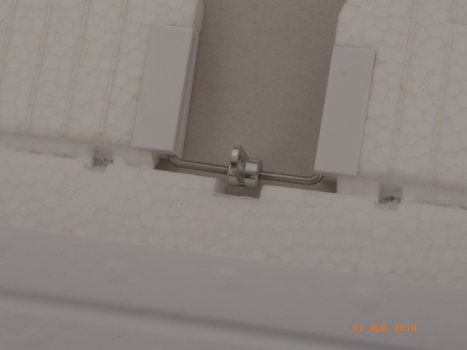 Speaking of the elevator, have a look at this photo and you can see why all the controls are so precise, we have not seen such an excellent drive attachment on any plane we have reviewed to date.
Speaking of the elevator, have a look at this photo and you can see why all the controls are so precise, we have not seen such an excellent drive attachment on any plane we have reviewed to date.
We did like the clutch arrangement on the propeller shaft as it provides for easy removal and adds a significant amount of strength to the drive system against bending in a crash situation. We did find, however, that either this or the Spinner base had a slight imperfection, as the propeller and spinner did not run true. (Note, a new spinner from the suppliers fixed this immediately and it now spins true.)
 Visual Quality
Visual Quality
Armed with LED navigation lights and the manufactures excellent quality and attention to detail, this is ‘plane is superb to behold and lends itself to being a mantle piece display item. To really finish the plane off and here I’m being really picky, they provided an LED dome on the tail but there is no LED or wiring. This could have been the final coup de gra effort!
 Transmitter
Transmitter
This is a locked 2.4 GHz transmitter (not DSM2 compatible) manufactured to suit the ‘planes requirements, it is capable of being changed to MODE 1 or Mode 2 very easily. In fact, a flick of a switch and the turning of two screws will see it changed to Mode 2 in 2 minutes and 10 seconds. It has sufficient range and provision of trim adjustment knobs and sliders to accommodate all that you will need to fly the ‘plane. The transmitter is also capable of being wirelessly operable in a trainer hook up situation with the same transmitter. Elevator and aileron are tied to the same rates, so whatever you set, must apply to both. Be a little careful though as the low battery warning is only a red light.
Supplied Charger
An adequate 12 volt DC input Li-Po charger is supplied, but whilst it appears to work well, it only charges via the balance connection plug. We must state, however, that check readings on cells after being charged, verified that the charger still did what it was designed for.
Features include:
The Art – Tech 500 Class Cessna 182 offers an extremely precise scale version of the popular aircraft, right down to the seating and instrument panel. The kit is complete with:
6 Channel 2.4GHz radio gear and everything else to get flying
Constructed from EPO
All radio gear, speed controller and motor installed in aircraft
Detailed instruction book with many easy to follow photos and guide to flying
Specifications
Wingspan: 1300mm (51.2″)
Length: 993mm (39.0″)
Weight: 1170g (41.3oz)
Motor: High Torque Brushless Outrunner (3715)
Battery: 11.1V 2400mah Li-Po
Radio: 6 Ch 2.4GHz transmitter and receiver, 9gm servos
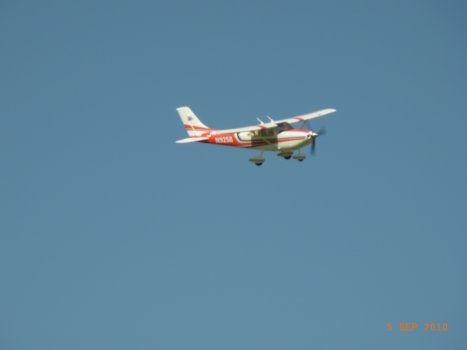 First Flight
First Flight
With such precise fitment of all parts, we expected this plane to fly well but we were surprised to find that it handled a wind speed of 18 kms per hour and subsequently flew equally as well as the best ‘plane we have flown out of the 12 aeroplanes tested to date. We were flying on a HEI battery, our friends at HEI Hobby Express International seem to have Intellect batteries of any size, capacity and discharge rate that you could possibly want and are widely available at most hobby stores.
As an expert and as a beginner we deduced the following:
As a Beginner on your own:
• Not really for beginners, too nice to crash!
As an Intermediate flyer with access to advice
Pros
• Very nice looking plane with reasonably easy construction
• Has ailerons and stick configuration is correct for all future 5 channel planes
• Predictable flying
• Takes off and lands well on grass
• With flaps extended it will take off and land slower
• Turns extremely sharp on taxying
• Able to fly fast when demanded
• Able to fly in half a football/soccer area and larger
• Able to fly reasonably slowly with flaps on
Cons
• If you wish to use the flaps you need to have access to advice on flaps from someone with RC plane experience or TX’s in tandem to obtain experience
• Need to get proficient using a small slow inexpensive raw recruit training-suited ‘plane as shown in final comparison grid first
• Not so easy to repair main wing
• Another complication (flaps) to get used to
As an accomplished RC flyer:
Pros
• An extremely lovely predictable ‘plane
• Short take off distance required only
• Adequately powered with large variance of low/high speed capabilities of flight
• Robust construction
• Lands and takes off on grass easily
• A responsive aeroplane
• Excellent fly time
• Fast and capable
• High quality transmitter
Cons
• Front wheel assembly has no spring or telescopic function to wash off impact and so a hard landing will damage this unit as it is a fairly heavy plane.
Summary conclusion – Art-Tech 500 ClassCessna182
The Art-Tech Cessna 500 imported by EGO – Models is at present a very strong contender to win “Plane of the Year” in its class. Early in November 2010, we will be posting a review which will set out a comparison of 16 – 20 different planes with brand name and model name. We will supply a point system evaluation on everything you would wish to know before buying a plane and will cover at least these aspects (singularly addressed).
• Build Quality
• Readiness for uniform flight
• Grass take off • Grass landing • Aerobatics
• Tolerated wind speed
• Flying in less than oval size – beginner, Intermediate and expert
• Flying in oval size – beginner, Intermediate and expert
• Flying in over an oval size – beginner, Intermediate and expert
• Supplied TX
• As well as other items of interest
– If any of our readers want additional data please contact us with your suggestion and we will include it within the grid.
Available from www.rchobbies.com.au at approximately $399 Aud, the Cessna 182 500 Class is excellent value as it is extremely well finished. Everything is provided and it looks stunning both stationary and in flight. Coupled with outstanding flight behaviour, you will not regret the day you bought it.


